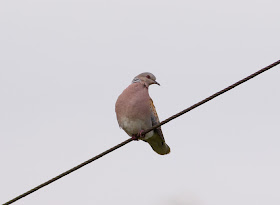Whilst visiting the Red
Helleborine in Buckinghamshire, the warden informed me of a nearby colony of
Black Hairstreaks, a species of butterfly I had yet to see and one which has a
stronghold down in the Chilterns. With numerous individuals often found at
Whitecross Green Woods in Oxfordshire and armed with instructions as to their
favourite haunts on the reserve, we headed off to try and catch up with this
rarest of hairstreaks. With an exceptionally short flight season consisting of
the last two weeks in June and the first week in July, we were nearing the end
of when they would be active, but I was still hopeful that we would be able to
spot some individuals, with the butterfly having apparently had a good year in
2015.
The weather wasn’t perfect -
overcast with a slight breeze - although this can often work favourably whilst
searching for hairstreaks, which venture lower down in these types of
conditions and can often be found sheltering at eye level as opposed to
fluttering manically in the treetops.
Despite the clouds, the
reserve was absolutely alive with butterflies - Meadow Browns and Ringlets
darted through the grass whilst Small and Large Skippers buzzed from flower to
flower. Stalking the Blackthorn bushes along the edge of the main ride however revealed
nothing apart from several bees taking advantage of a clear glut of nectar. I
was determined there must be a Black Hairstreak still active in amongst the
Blackthorn bushes so headed back, keeping a sharp look out for any movement.
Focusing on a low down branch I
spotted a shade of brown – and sure enough upon looking closer, there as clear
as day and sat perfectly on a leaf was a pristine Black Hairstreak, completely
in the open and almost waiting to be found.
Very similar to White-letter Hairstreaks, Black Hairstreaks can be told apart by the row of distinctive black spots running along the inside of the orange band on the underside of the hindwing, which are absent in White-letter Hairstreaks. The White-letter Hairstreaks also have a more prominent white line on the hindwing which forms the letter ‘W’, and this is far less pronounced in Black Hairstreaks where the line is relatively straight. In flight and darting around the treetops however, it is nearly impossible to separate the two, so I was extremely glad our butterfly was settled and still.
Very similar to White-letter Hairstreaks, Black Hairstreaks can be told apart by the row of distinctive black spots running along the inside of the orange band on the underside of the hindwing, which are absent in White-letter Hairstreaks. The White-letter Hairstreaks also have a more prominent white line on the hindwing which forms the letter ‘W’, and this is far less pronounced in Black Hairstreaks where the line is relatively straight. In flight and darting around the treetops however, it is nearly impossible to separate the two, so I was extremely glad our butterfly was settled and still.
One of our rarest species of
butterfly, Black Hairstreaks have a very restricted distribution, occurring only
in a corridor running from Oxfordshire to Cambridgeshire. Whilst the population
is currently stable, the future of this fragile butterfly undoubtedly lies in
appropriate habitat management and protection which will ensure its ongoing
survival.
Watching my prized find and
calling others who were searching over, their movement sadly flushed it from
its resting spot. Thankfully it only fluttered a few metres away to the next
tree, and posing with the classic position of the wings closed, we watched as
it slowly turned, angling its wings towards the sun to make the most of the
warmth.
Eventually, the Hairstreak tired of our attention and fluttered gracefully over the leaves, spiralling higher up before eventually becoming lost in the tangle of Blackthorn.
Eventually, the Hairstreak tired of our attention and fluttered gracefully over the leaves, spiralling higher up before eventually becoming lost in the tangle of Blackthorn.
An abundance of Marbled Whites
proved to be another attraction at this reserve, flitting amongst the purple
flowerheads and jostling for position over the best spikes. With no Marbled
Whites in Cheshire, this is a butterfly I rarely get to see often, so I relished
the opportunity to observe them in such large numbers. Having a tendency to fly
strongly and constantly move whilst nectaring, I always find them a difficult subject
photographic wise, so spent a good while getting up close to them – one even
landed on my shoe!
The Chilterns really is one of my favourite places, and the beautiful purring of a Turtle Dove drifting on the breeze was a perfect soundtrack to the afternoon. It wasn’t long before one burst through the trees and flew swiftly overhead, the diagnostic diamond shaped black tail clear to see before it landed on a nearby wire to put on a fantastic show as it purred happily above our heads.
It’s really sad to think that this
once abundant farmland dove is in such a steep decline (up to 96% in some areas
- making it one of the fastest declining British birds) and that one day we
might sadly lose this enigmatic summer visitor from our shores entirely.
The Chilterns really is one of my favourite places, and the beautiful purring of a Turtle Dove drifting on the breeze was a perfect soundtrack to the afternoon. It wasn’t long before one burst through the trees and flew swiftly overhead, the diagnostic diamond shaped black tail clear to see before it landed on a nearby wire to put on a fantastic show as it purred happily above our heads.










No comments:
Post a Comment